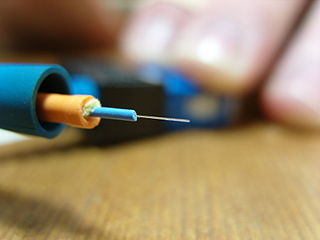
In fiber-optic communications, wavelength-division multiplexing (WDM) is a technology which multiplexes a number of optical carrier signals onto a single optical fiber by using different wavelengths of laser light. This technique enables bidirectional communications over a single strand of fiber as well as multiplication of capacity.

Altice USA, Inc., commonly known as Altice, is an American cable television provider with headquarters in New York City, owned by the Franco-Israeli businessman Patrick Drahi. It delivers pay television, Internet access, telephone services, and original television content to approximately 4.9 million residential and business customers in 21 states.

A passive optical network (PON) is a fiber-optic telecommunications technology for delivering broadband network access to end-customers. Its architecture implements a point-to-multipoint topology in which a single optical fiber serves multiple endpoints by using unpowered (passive) fiber optic splitters to divide the fiber bandwidth among the endpoints. Passive optical networks are often referred to as the last mile between an Internet service provider (ISP) and its customers. Many fiber ISPs prefer this technology.

Hibernia Networks, alternately known as Hibernia Atlantic, was a privately held, US-owned provider of telecommunication services. It operated global network routes on self-healing rings in North America, Europe and Asia including submarine communications cable systems in the North Atlantic Ocean which connected Canada, the United States, the Republic of Ireland, the United Kingdom and mainland Europe. Hibernia managed cable landing stations in Dublin, Republic of Ireland; Coleraine, Northern Ireland; Southport, England; Halifax, Canada; Lynn, Massachusetts, United States.

Multi-mode optical fiber is a type of optical fiber mostly used for communication over short distances, such as within a building or on a campus. Multi-mode links can be used for data rates up to 800 Gbit/s. Multi-mode fiber has a fairly large core diameter that enables multiple light modes to be propagated and limits the maximum length of a transmission link because of modal dispersion. The standard G.651.1 defines the most widely used forms of multi-mode optical fiber.

Fiber to the x or fiber in the loop is a generic term for any broadband network architecture using optical fiber to provide all or part of the local loop used for last mile telecommunications. As fiber optic cables are able to carry much more data than copper cables, especially over long distances, copper telephone networks built in the 20th century are being replaced by fiber.
Municipal broadband is broadband Internet access offered by public entities. Services are often provided either fully or partially by local governments to residents within certain areas or jurisdictions. Common connection technologies include unlicensed wireless, licensed wireless, and fiber-optic cable. Many cities that previously deployed Wi-Fi based solutions, like Comcast and Charter Spectrum, are switching to municipal broadband. Municipal fiber-to-the-home networks are becoming more prominent because of increased demand for modern audio and video applications, which are increasing bandwidth requirements by 40% per year. The purpose of municipal broadband is to provide internet access to those who cannot afford internet from internet service providers and local governments are increasingly investing in said services for their communities.
Phonoscope Communications is a broadband and communications provider with corporate headquarters in Houston, Texas. The company's infrastructure spans eight counties and reaches distant locations such as Baytown, Galveston, Freeport, Magnolia, Richmond-Rosenberg, Splendora, Texas City and Willis, Texas.

Frontier Communications Parent, Inc. is an American telecommunications company. Known as Citizens Utilities Company until 2000, Citizens Communications Company until 2008, and Frontier Communications Corporation until 2020, as a communications provider with a fiber-optic network and cloud-based services, Frontier offers broadband internet, digital television, and computer technical support to residential and business customers in 25 states. In some areas it also offers home phone services.

Fiber-optic communication is a method of transmitting information from one place to another by sending pulses of infrared or visible light through an optical fiber. The light is a form of carrier wave that is modulated to carry information. Fiber is preferred over electrical cabling when high bandwidth, long distance, or immunity to electromagnetic interference is required. This type of communication can transmit voice, video, and telemetry through local area networks or across long distances.

Internet in Russia, or Russian Internet, and sometimes Runet, is the part of the Internet that is related to Russia. As of 2015, Internet access in Russia is available to businesses and home users in various forms, including dial-up, cable, DSL, FTTH, mobile, wireless and satellite.
40 Gigabit Ethernet (40GbE) and 100 Gigabit Ethernet (100GbE) are groups of computer networking technologies for transmitting Ethernet frames at rates of 40 and 100 gigabits per second (Gbit/s), respectively. These technologies offer significantly higher speeds than 10 Gigabit Ethernet. The technology was first defined by the IEEE 802.3ba-2010 standard and later by the 802.3bg-2011, 802.3bj-2014, 802.3bm-2015, and 802.3cd-2018 standards. The first succeeding Terabit Ethernet specifications were approved in 2017.

A fiber-optic cable, also known as an optical-fiber cable, is an assembly similar to an electrical cable but containing one or more optical fibers that are used to carry light. The optical fiber elements are typically individually coated with plastic layers and contained in a protective tube suitable for the environment where the cable is used. Different types of cable are used for optical communication in different applications, for example long-distance telecommunication or providing a high-speed data connection between different parts of a building.
Broadband Internet in Israel has been available since the late 1990s in theory, but it only became practically accessible to most customers in 2001. By 2008, Israel had become one of the few countries with developed broadband capabilities across two types of infrastructure—cable and DSL—reaching over 95% of the population. Actual broadband market penetration stands at 77%, ranked 7th in the world. In 2010, Israel was ranked 26th in The Economist's Digital Economy Rankings. In 2022, Israel was ranked first for digital quality of life by Surfshark.
Fiber to the premises (FTTP) in the United States is provided on a limited geographical basis by Google Fiber, Verizon, Lightower, and a number of smaller Internet Service Providers.
Communication services in American Samoa are diversified among telephony, radio broadcasting, television, and Internet services.
10G-PON is a 2010 computer networking standard for data links, capable of delivering shared Internet access rates up to 10 Gbit/s over existing dark fiber. This is the ITU-T's next generation standard following on from GPON or Gigabit-capable PON. Optical fibre is shared by many subscribers in a network known as FTTx in a way that centralises most of the telecommunications equipment, often displacing copper phone lines that connect premises to the phone exchange. Passive optical network (PON) architecture has become a cost-effective way to meet performance demands in access networks, and sometimes also in large optical local networks for "Fibre-to-the-desk".

Verizon Fios is a bundled Internet access, telephone, and television service provided by Verizon Communications that operates over a fiber optical network within the United States.
NG-PON2, Next-Generation Passive Optical Network 2 is a 2015 telecommunications network standard for a passive optical network (PON). The standard was developed by ITU and details an architecture capable of total network throughput of 40 Gbit/s, corresponding to up to 10 Gbit/s symmetric upstream/downstream speeds available at each subscriber.















